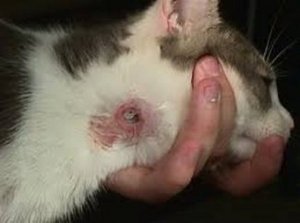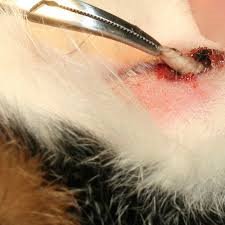Cuterebra is a parasite that can cause severe illness in cats and kittens

Cuterebra adults are flies that lay eggs near rodent or rabbit burrows. A cat or kitten is infected by investigating burrows while hunting outdoors. Typically the larva enters the cat’s mouth, and then migrates to another part of the cat’s body. It takes three to six weeks from infection for the newly hatched larva to develop into a fully formed third-stage larva in cats.
Migration in cats can make an adult cat very sick with a very small larva. Conversely, kittens sometimes have huge grubs (larvae). Migration involving the nose or eye can cause deformity or blindness in a young kitten. Cats and kittens can also have signs of respiratory illness and fever. Migration of a larva can involve the brain or spinal cord and cause neurological illness.

AAAH | Contributor
I treat this condition by removing the larva. Usually I give the cat a dose of Capstar, a flea treatment pill to kill the cuterebra larva (this is an insect, the drug is very safe for the cat, but this is not a labeled use for the drug). The cat is then sedated, and the breathing pore is enlarged and larva is removed with hemostats and the wound is flushed. Usually the cat starts to feel better in one to two days, but the neck area is often slow to heal.
There may be age-related immune reaction to the parasite. We see tiny, thin sickly larva that cause severe fever and lethargy in adult cats, and conversely, huge grubs in tiny kittens. If the grub is not in a terrible place like the eye socket or nose, the kitten doesn't seem to be as sick as the older cat.
This parasite can also occur in dogs, but this is less common in our southeast Michigan practice. There are approximately 30 species of cuterebra; rabbits and rodents are the natural hosts in our area. Topical insecticides, such as Frontline Plus may provide some protection from infestation. For more information on this condition visit CAPC Vet.
Dr. Jess Franklin specializes in geriatric medicine, acupuncture, ultrasound and managing chronic disease at Ann Arbor Animal Hospital.


Comments
Nerak
Mon, Jul 1, 2013 : 10:50 a.m.
Which is the correct spelling of this condition, please? The headline and article spell it both "cuterebra" and "cutereba."
Sarah Rigg
Fri, Jul 5, 2013 : 1:06 p.m.
The correct spelling is "cuterebra". That's being corrected throughout the article.